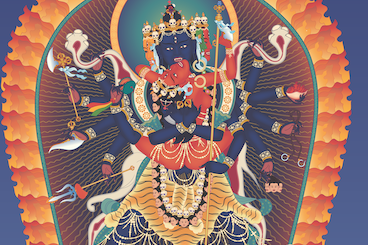
Vajrayana Buddhism
Vajrayana Buddhism (Devanagari: बज्रयान) is also known as Tantric Buddhism, Tantrayāna, Mantrayana, Mantranaya, Secret Mantra, Esoteric Buddhism and the Diamond Vehicle. These terms are not regarded as equivalent. Vajrayana is as an extension of Mahayana Buddhism since it differs in its practices, rather than its philosophy. The Mahayana has two practice paths: the Sutrayana method of perfecting good qualities and the Vajrayāna method of taking the intended outcome of Buddhahood as the path. The Vajrayana requires mystical experience in order to experience Buddha-nature prior to full enlightenment. In order to transmit these experiences, a body of esoteric knowledge has been accumulated by Buddhist tantric yogis and is passed via lineages of transmission. In order to access this knowledge, the practitioner requires initiation from a skilled spiritual teacher or guru. The Vajrayana is often viewed as the third major Yana (or “vehicle”) of Buddhism, alongside the Theravada and Mahayana. According to this view, there were three “turnings of the wheel of dharma”. In the first turning Shakyamuni Buddha taught the dharma as the Four Noble Truths at Varanasi which led to the Hinayana schools, of which only the Theravada remains today. In the second turning the Perfection of Wisdom sutras were taught at Vulture’s Peak and led to the Mahayana schools. The teachings which constituted the third turning of the wheel of dharma were taught at Shravasti and expounded that all beings have Buddha-nature. This third turning is described as having led to the Vajrayana. The Vajrayana subscribes to the two truths doctrine of conventional and ultimate truths. Experiencing ultimate truth is the purpose of all the various tantric techniques practiced in the Vajrayana.